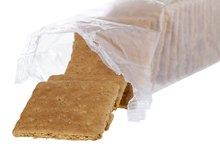How to Keep Weight Off After a Low-Carb Diet
One of the easiest ways to keep weight off after a low-carb diet is to stay on a carb-restricted maintenance plan. But you can also go with any healthy eating plan and keep pounds away the old-fashioned way -- by eating just enough calories to maintain your weight. Enlisting the help on an online calorie counter is perfect for this. Regular exercise rounds out the plan by boosting metabolism. Most importantly, create a diet and exercise plan you can stick with for the long run.
Continue to Limit Carbs
If you lost weight following a low-carb diet, you may want to stick with the plan that was successful. Most programs provide a maintenance plan, with food lists, a calorie calculator, dietary and low-carb goals that will help you keep the weight off. Plus you can follow them for as long as you like.
If you developed your own low-carb plan and wonder about maintenance, use the Atkins plan as a guide. Increase your daily net carbs -- total carbs minus fiber -- but do it gradually. Add 5 to 10 grams weekly until you reach 80 to 100 grams of net carbs daily. Although the maintenance phase lets you add starchy veggies, whole grains and beans to the menu, do it slowly to be sure you don't overdo it with carbs. With a little trial and error, you can pinpoint the carb intake that works to keep the pounds off.
You could go up to 130 grams of net carbs daily, which is higher than the Atkins plan, yet still in a low-carb range. But if your metabolism adjusted to lower levels of carbs, the pounds may begin to creep up again. Weigh yourself once a week. If your weight begins to go up, take action by dropping to a lower daily carb level before you gain 5 pounds.
Set a Daily Calorie Goal
How to Write a Time Plan for Foods & Nutrition
Learn More
If you plan to stick with a low-carb maintenance plan, you may not need to track calories. But if you go back to a typical diet with more than 100 grams of net carbs daily, it’s time to get back to the basics of calorie counting. This is the best way to keep calories low enough to prevent regaining weight.
To get specific about tracking calories, begin by using the Baylor College of Medicine calorie calculator. It will quickly tell you the number of calories you need daily to maintain your current weight. Then it's a matter of tallying your daily calories to be sure you don't get more than your maintenance calories.
Write down everything you eat and drink for about a week, then add up the calories to verify you're within the maintenance goal. Once you're familiar with the calories in the foods you normally eat, you won't have to keep tracking every item, but be sure to check calories when you add new foods or after a splurge. As soon as you discover you've over-consumed, cut back for a few days to offset the damage.
Keep Weight Off With a Healthy Diet
You can also keep the weight off by limiting calories while following a healthy, well-balanced eating plan. This type of diet follows the classic MyPlate plan, in which you fill half of your plate with mostly veggies and some fruit, then divide the other half between whole grains and protein foods. Three servings of dairy and some healthy oils round out the daily food plan.
The Dietary Guidelines for Americans offer various levels of meal patterns. For instance, some people could maintain their weight eating 2 cups of veggies, 1 1/2 cups of fruit, 5 ounces of grains, 3 cups of dairy, 5 ounces of protein and some healthy oils daily. Others might need a little more or less food.
This kind of long-term plan can easily work with personal choices, such as a vegetarian diet. But no matter which foods you prefer, don’t skimp on protein -- you’ll need it to keep your muscles strong. And be sure to eat plenty of vegetables. They’re high in water and fiber, which are filling and help you avoid overeating.
The key to maintaining weight with a basic balanced diet is to limit portions and the number of meals you eat, according to experts at the Harvard Medical School. If your plate is filled mostly with veggies and protein, plus a small serving of healthy carbs like whole grain brown rice, chances are you won’t blow your calorie budget.
Maintain Weight Loss With Regular Exercise
Diet & Exercises for Men to Build Muscle & Lose Stomach Fat
Learn More
After you lose weight, regular exercise is key to keeping it off, suggests the Centers for Disease Control and Prevention. Just one caveat -- if you’ve been inactive, or you have a health condition like heart disease, arthritis or diabetes, talk to your doctor before beginning or resuming an exercise regimen.
Start slowly and gradually increase your activity to 150 minutes of moderate aerobic activity or 75 minutes of high-intensity aerobic exercise each week. During moderate activities like brisk walking and bike riding, you should still be able to carry on a conversation. By comparison, you should be breathing too hard to talk during high-intensity activities. Good examples include running, swimming and competitive sports.
It’s also important to engage in muscle-strengthening exercises twice a week. Lifting weights, working with resistance bands, doing pushups, sit ups and even heavy outdoor work such as shoveling are all activities that give muscles a good workout. As you build muscle, your metabolism also increases slightly, which helps you keep weight off.
Related Articles
References
- Atkins: Phase 3 Overview: Eating More Carbs
- Atkins 20 Diet Plan: How Does It Work?
- Baylor College of Medicine: Adult Energy Needs and BMI Calculator
- Harvard Medical School: Calorie Counting Made Easy
- Atkins: Phase 4: Controlling a Healthy Lifestyle
- Dietary Guidelines for Americans 2015 – 2020: USDA Food Patterns: Healthy U.S.-Style Eating Pattern
- Centers for Disease Control and Prevention: How Much Physical Activity Do Adults Need?
- Harvard Medical School: Add Strength Training to Your Fitness Plan
Resources
Writer Bio
Sandi Busch received a Bachelor of Arts in psychology, then pursued training in nursing and nutrition. She taught families to plan and prepare special diets, worked as a therapeutic support specialist, and now writes about her favorite topics – nutrition, food, families and parenting – for hospitals and trade magazines.








